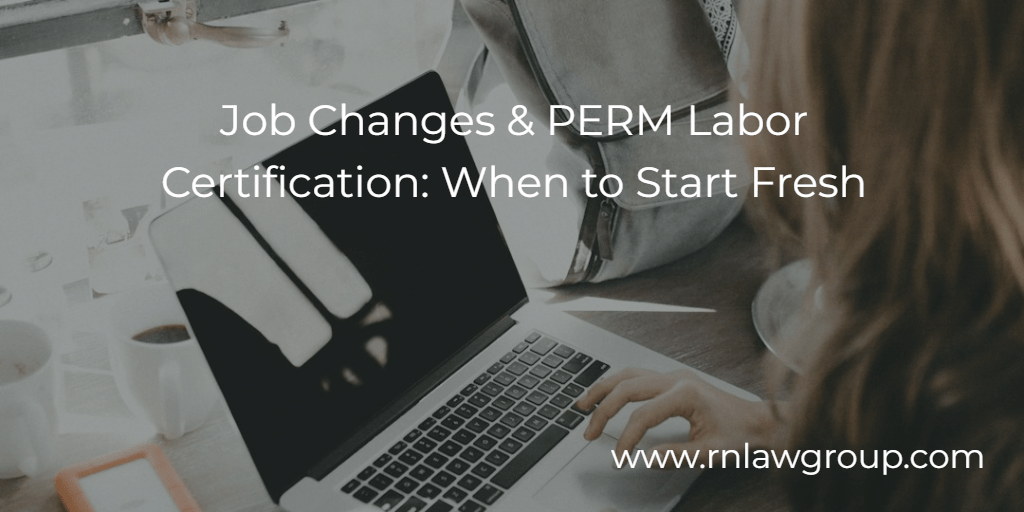
Job Changes & PERM Labor Certification: When to Start Fresh
The PERM labor certification process is a critical step for employers in the U.S. seeking to hire foreign workers permanently. It involves proving that there are no qualified U.S. workers available for the job and that hiring a foreign worker will not adversely affect the wages and working conditions of U.S. workers. However, changes to the job or the conditions under which it was certified can necessitate the need for a new PERM labor certification. Understanding when these changes require a new PERM labor certification is crucial for employers to remain compliant with U.S. Department of Labor (DOL) regulations.
Key Factors That Can Trigger the Need for a New PERM Labor Certification
- Changes in Job Duties: If the core responsibilities of the job change significantly from what was originally certified, a new PERM labor certification may be required. USCIS will examine the following factors when determining if the jobs are the same or similar:
- The Standard Occupational Classification (SOC) system;
- The job duties of both positions;
- The skills, experience, education, training, licenses or certifications specifically required to perform each job;
- The wages associated with each position; and
- Any other relevant and credible evidence submitted by the applicant.
- Changes in Job Location: The job location is a critical component of the labor market test conducted during the PERM labor certification process. The PERM labor certification is specific to the area of intended employment. The area of intended employment means the area within normal commuting distance of the place (address) of intended employment. If the place of intended employment is within a Metropolitan Statistical Area (MSA), any place within the MSA is deemed to be within normal commuting distance of the place of intended employment. If the location of the job changes, especially to a different MSA, it might trigger the need for a new PERM labor certification. If the job is one that involves work in various unanticipated locations throughout the U.S. or travel to multiple client locations nationwide, then a new PERM labor certification may not be required if it was drafted to account for the possibility of relocation.
- Job Promotions and Salary Changes: When a wage increase is due to a natural progression within the same job family, such as a promotion or advancement that does not substantially change the core job duties, there is a valid argument that a new PERM labor certification is not required. If the wage increase is due to a significant change in the job duties or a promotion to a different position that is substantially different from the original one certified in the PERM application, then a new PERM labor certification may be necessary.
- Company Restructuring: Mergers, acquisitions, or any restructuring that affects the employer’s federal employer identification number (FEIN) can lead to the need for a new PERM labor certification. If the entity sponsoring the foreign worker undergoes significant changes that affect its legal identity or structure, a new PERM labor certification might be necessary.
Why a New PERM Labor Certification is Necessary
The PERM labor certification process is designed to protect U.S. workers by ensuring that the hiring of foreign workers does not negatively impact their employment opportunities and working conditions. Any significant changes to the job or the employer’s circumstances can alter the conditions under which the labor market test was conducted. A new PERM labor certification ensures that the DOL’s assessment of the labor market remains accurate and fair under the new conditions.
Steps to Take When a New PERM Labor Certification is Required
- Obtain a New Prevailing Wage Determination: Before filing a new PERM application, employers must obtain a new prevailing wage determination from the DOL. The prevailing wage rate is defined as the average wage paid to similarly employed workers in a specific occupation in the area of intended employment. The DOL issues a prevailing wage determination based on the specific position, job duties, requirements for the position, the area of intended employment, travel requirements (if any), among other things.
- Undertake New Recruitment Efforts: Employers must go through the PERM recruitment process again. The PERM recruitment process involves placing job advertisements in multiple recruitment mediums mandated by the DOL. There are mandatory recruitment steps for both nonprofessional and professional occupations. Also, there are additional recruitment steps that need to be taken if the PERM application is for a professional occupation. The employer will make a good faith effort to recruit U.S. workers by reviewing any resumes received and conducting interviews.
- File a New PERM Application: Once the prevailing wage determination and recruitment process are complete, the employer can file a new PERM application with the DOL.
- Documentation: The employer must keep detailed records of their recruitment efforts. It is important to note that an employer is not required to submit supporting documentation when a PERM application is filed. The DOL has implemented a quality control process in the form of audits to ensure compliance with all PERM regulations. In the event of an audit, the employer will submit documentation of all recruitment efforts.
Reddy Neumann Brown PC has been serving our clients for over 25 years. Our team is dedicated to helping our clients navigate the U.S. business immigration system by offering prompt, practical, and professional advice. Because the U.S. business immigration system can be tricky, it is always best to contact a qualified immigration attorney to help come up with the proper solution for each individual case.
By: Camille Joson
Camille Joson is a Senior Associate Attorney in Reddy Neumann Brown PC’s PERM Labor Certification Department, where she assists clients in the beginning stages of the employment-based green card process. Camille guides clients through the PERM Labor Certification process from start to finish and has handled hundreds of PERM applications throughout her career.

